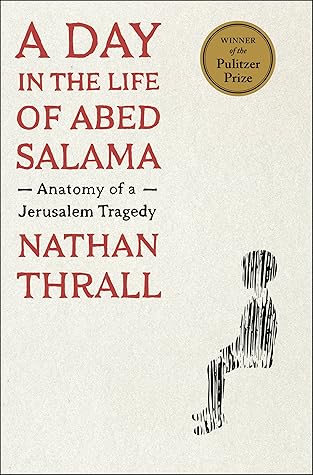More on this book
Community
Kindle Notes & Highlights
Read between
July 4 - July 6, 2024
THE FIRST INTIFADA broke out in December 1987, a year and a half after Abed finished high school. It began as a series of spontaneous protests that erupted when an Israel Defense Forces semitrailer collided with a station wagon in Gaza, killing four Palestinian workers. The protests spread, fueled by years of anger at what Israel’s defense minister called an “iron fist policy.” They quickly transformed into the first organized mass uprising against the occupation, with thousands of street battles pitting stone-throwing Palestinian youth against Israeli troops equipped with armored vehicles and
...more
More than 1,100 Palestinians were killed by Israeli soldiers or civilians during the six years of the uprising. Another 130,000 were wounded and some 120,000 were jailed. In those years, Israel had the largest per capita prison population in the world.
The Oslo Accords were purportedly for an interim period of five years that was supposed to conclude with negotiations over all the major issues, including the status of Jerusalem. In advance of those negotiations, Israel had every motivation to weaken the Palestinians’ claims to the city—to diminish their presence, increase Jewish settlement, and make East Jerusalem’s absorption into Israel an irrefutable fact. Building permits for Palestinians were withheld, homes were demolished, green ID holders were evicted, more checkpoints sprung up overnight, and entrance permits to the city became
...more
In fact, Oslo had furthered Israel’s goal of holding on to maximal land with minimal Palestinians on it. The agreements had fractured the West Bank into 165 islands of limited self-government, each one surrounded by a sea of Israeli control. Trapped in these islands and watched over by PA security forces that were subservient to Israel, Palestinians mocked the impotence of their Authority, their sulta, calling it a salata, a salad, instead. The uprising brought large numbers of IDF tanks into Palestinian cities, including the sulta’s administrative capital in Ramallah, where Israel laid siege
...more
UN voted to partition Palestine in November 1947. The decision triggered a civil war that culminated in the Nakba, the mass expulsion and flight of more than 80 percent of Palestinians from the territory that became Israel. In April 1948, several months into the civil war and just days before Passover, the British Mandatory forces governing the country began to withdraw from Haifa. As the British departed, Jewish paramilitary units launched an attack on the Palestinian parts of the city, calling it Operation Bi’ur Chametz, a reference to the ritual purging of bread from Jewish homes before the
...more
This highlight has been truncated due to consecutive passage length restrictions.
Three weeks after the fall of Haifa, Israel declared independence. By that time, some quarter of a million Palestinians had been made refugees, among them 90 percent of the Arab residents of Haifa and Jaffa, the most populous Palestinian cities. Israel’s war with the neighboring Arab states had not yet begun.
Three years later, in 1988, the PLO offered Israel a historic compromise, consenting to a Palestinian state in the occupied territories, just 22 percent of the homeland. The proposed state excluded Haifa, Jaffa, and the other towns its leaders had been exiled from, the places to which they had spent decades fighting to return.
Rabin was emphatic that there would be no Palestinian state, no capital in Jerusalem, more settlements annexed to Jerusalem, more settlement blocs in the West Bank, and that Israel would never return to the boundaries it had prior to the 1967 war, even though they comprised a full 78 percent of historic Palestine. Somewhere within the West Bank and Gaza, the remaining 22 percent—or the part of it that Israel hadn’t settled, annexed, or set aside for permanent military control—the Palestinians would be granted “less than a state,” as Rabin called it. But even these crumbs were too much for some
...more
International law prohibits an occupying power from plundering the resources of the occupied. Pillage is a war crime. But the court ruled unanimously that the state was permitted to exploit the West Bank’s natural resources. The reason given by its president, Dorit Beinisch, who was considered a liberal justice in Israel, was that the occupation was so long-standing that it required the “adjustment of the law to the reality on the ground.”
In 1994, the year the PA was established, Israel put a fence around Gaza and laid the foundation for what would later become the separation barrier, building the first walls in the West Bank.
In February 1994, a Brooklyn-born religious settler, Baruch Goldstein, murdered twenty-nine Palestinian worshippers in Hebron. Significantly, he chose to do it on Purim, the holiday commemorating the biblical story of the Jews of Persia foiling a plot to destroy them and then killing “all their enemies with the stroke of the sword, and with slaughter, and destruction.” That year, Purim fell on the third Friday of Ramadan. Goldstein, a resident of Kiryat Arba near Hebron and a captain in the IDF reserves, put on his army uniform, took his assault rifle, and entered the Ibrahimi Mosque during
...more
This highlight has been truncated due to consecutive passage length restrictions.
The Purim bloodshed had consequences well beyond Hebron, leading, as it did, to the first bus suicide bombing, claimed by Hamas in retaliation. Many suicide bombings followed that year and in the years after, and the architecture of segregation grew. It was an irony of Oslo that those most vehemently opposed to it—Jewish and Palestinian attackers—did the most to further the process of segmentation at its core.


